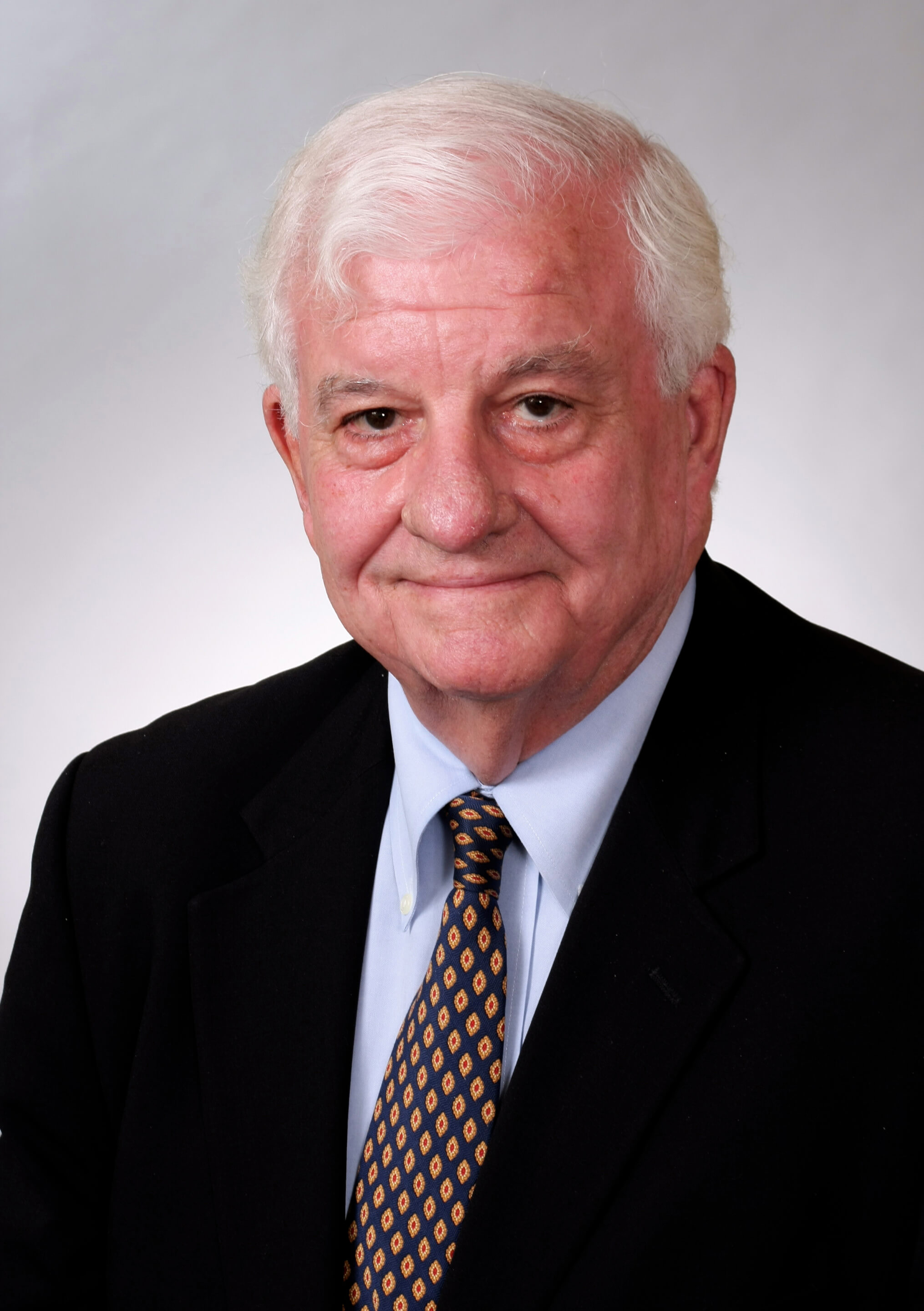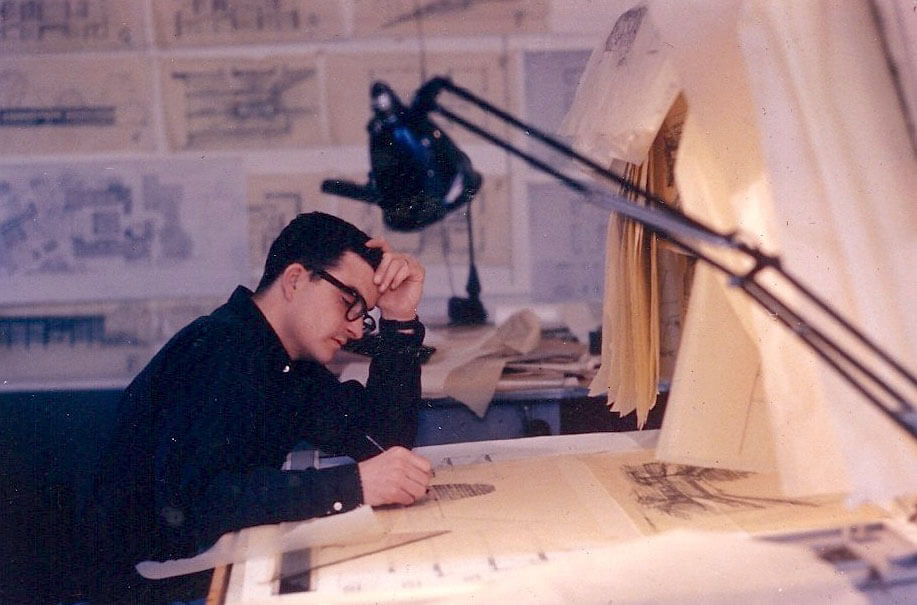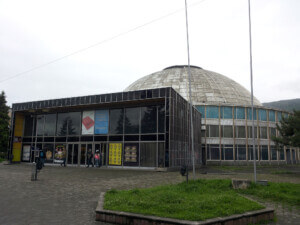James Lee “Jim” Nagle, one of a group of “rebel” architects known as the Chicago Seven, died January 19 of complications from Alzheimer’s Disease. He was 83.
Nagle was a founder of what is now Sheehan Nagle Hartray Architects, a 100-person firm with offices in Chicago and London.
Born in Iowa City, Iowa, and educated on both coasts of the United States, Nagle was considered the quintessential Midwestern architect, happy to call Chicago home and proud of its reputation as a center for world-class modern architecture, especially works by Ludwig Mies van der Rohe.
But he wasn’t afraid to critique his adopted hometown and challenge the status quo, characteristics that ultimately led to his involvement in the Chicago Seven.
Along with architects such as Thomas Beeby, Harry Weese, and the late Stanley Tigerman, Nagle was a staunch advocate for pluralism in architecture. He wanted Chicago to be known for more than its Miesian towers. He encouraged architects to go beyond the glass box and the International Style of architecture as the city evolved in the late 20th century.
Nagle made it clear that he didn’t have an issue with Mies’ buildings. What troubled him, he said, were the inferior imitations that followed.
“It wasn’t Mies that got boring,” he said in 2005. “It was the copiers that got boring[…] You got off an airplane in the 1970s and you didn’t know where you were.”
He was both challenged and exasperated by what he saw as a tendency on the part of Chicago builders and contractors to keep a tight lid on construction budgets.
“The good part of Chicago is that it’s pragmatic,” he once said, “and the bad part is that it’s pragmatic.”

Dismayed by the demolition in 1972 of Adler and Sullivan’s 1894 Chicago Stock Exchange Building—a loss that many have compared to the 1963 demolition of Pennsylvania Station in New York City—he also led an early push to recognize and save the best of Chicago’s historic buildings. He devoted seven years to the restoration of H. H. Richardson’s John J. Glessner House, the last remaining example of Richardson’s work in Chicago, to serve as the home of the Chicago chapter of the American Institute of Architects.
Colleagues say Nagle’s career shows that one person can make a difference in architecture, even in a city as big as Chicago.
“Jim’s success came early as one of a group of architects who claimed design independence from the orthodox Modernism that dominated Chicago architecture at the time,” said Don McKay, an architect who joined the firm in 1984 and is now a partner, in a statement. “Jim was a designer with good intuition and formidable intellect, qualities that helped him create new paradigms for urban housing that influenced a generation of Chicago architects.”
McKay added that Nagle’s residential projects demonstrated how architects could work in a modern idiom and yet produce buildings that were intimate and inviting.
“Jim’s architecture was rigorous in the traditions of Chicago architectural design but distinguished by an intimacy often lacking in contemporary modernist works,” he said. “His natural ease working with house and developer clients instilled confidence that extended to those who built his designs. His later house designs are a fully mature realization of modernism’s capacity for warm and welcoming architecture.”
Nagle was born to a family that owned a lumber business and groomed him to be part of it. On weekends, his father would take him along as he drove to job sites of competing companies to see what products they might be using that his company wasn’t. In an oral history on file with the Art Institute of Chicago, he noted that ‘nagle’ means nail in German, a fitting name for someone in the building industry.
Nagle worked for his family’s lumber business before college, getting hands-on construction experience that would serve him throughout his career. After high school, instead of staying with the family business, he decided to study architecture. He enrolled in Stanford University, which had a “pre-architecture” program for undergraduates at the time.
In 1959, Nagle received a bachelor’s degree from Stanford, where he met and married another student, the former Ann Steinbaugh. After a stint with the U. S. Navy, he earned a B.Arch degree from the Massachusetts Institute of Technology in 1962 and a master’s degree in architecture from Harvard University in 1964.
Nagle said in his oral history that he chose MIT because it was known for having a more “rigorous” course than Stanford. He also liked that “rationalist” professors such as Eduardo Catalano were balanced by “humanists” such as Pietro Belluschi, the grandfatherly dean of MIT’s architecture school. At Harvard, he encountered still more contrasts in design philosophy, signing up for studio courses from Jose Luis Sert, representing rationalism, and Ben Thompson, the father of the festival marketplace, representing humanism.
Nagle was exposed to many of the leading designers of the 1950s and 1960s at Stanford, MIT, and Harvard, from Walter Gropius to Marcel Breuer to Philip Johnson. He encountered luminaries such as Frank Lloyd Wright, Charles Eames, Paul Rudolph, and Fumihiko Maki. He got to see how architecture was shaped by seemingly competing forces firsthand, not only rationalism versus humanism, but also monumentality versus human-scaled design, and standardized corporate architecture versus idiosyncrasy and whimsy.
After Harvard, Nagle continued to pursue his own interests. He got a Fulbright scholarship and moved to the Netherlands with his wife to study housing. He chose the Netherlands, he said, because he wanted to learn more about the De Stijl art movement and all the slots in Holland were taken.

Returning from Europe, having lived on the East and West coasts as well as the Midwest, Nagle had to decide where to settle down and practice architecture. He interviewed with Skidmore Owings and Merrill to work in its New York City office and also with Stanley Tigerman, where he would be the third person in a three-person office in Chicago. He opted for Chicago, saying he preferred the intimacy of Tigerman’s small studio over the corporate atmosphere of SOM. The third person in the office was his supervisor, Laurence Booth.
Within 13 months, seeing how much design work was available, Nagle and Booth left Tigerman and opened their own office in Chicago, Booth & Nagle Architects. After Jack Hartray joined the firm and Booth went off on his own, the firm became known as Nagle Hartray & Associates.
Nagle received early attention when one of his Midwest houses was published in Architectural Record in the 1960s. With Booth and then Hartray, his office continued to gain recognition and clients for its efforts to create modern architecture that was “warm and welcoming.”
McKay said Nagle was a well-rounded principal because he was a designer who also had a good grasp of construction methods from having worked in his family’s business. One approach that set the office apart from others, he said, is that Nagle and Hartray wanted their architects to stay with a project all the way from preliminary design to punch list, rather than hand it off somewhere in the middle.
“Jim looked at a design problem from across the room, Jack as if it was in front of his nose, and it was up to the rest of us to fill the gap,” said McKay in his statement. “This instilled a firmwide comprehensive approach to design that made it a great place to become an architect. It was a kind of professional family.”
McKay said Nagle was a mentor to more than a few architects who took what they learned at Nagle Hartray and opened their own offices. For those who have stayed, he said, “much of what we experienced of Jim’s design approach remains with us. We approach each project comprehensively, with rigor and an independent attitude that opens creative possibilities. Our work has maintained an intimacy even as projects have grown larger and more complex[…] There will always be something of Jim in our work.”
One example of Nagle and Hartray’s support for pluralism is that as the firm grew and added partners, its name grew as well. At one point, it was known as it was Nagle, Hartray, Danker, Kagan, McKay and Penney. McKay said it got so long that partners asked that their names be removed and that the company go back to being Nagle Hartray, which it did.
In 2017, it became Sheehan Nagle Hartray Architects, after it was joined by Neil Sheehan, a specialist in data centers, and his associates from London.
Throughout his career, Nagle lent his time and expertise to a variety of design-related organizations and initiatives, including the Chicago School of Architecture Foundation (now the Chicago Architecture Center or CAC), AIA Chicago, National AIA Committee on Design, Chicago Architectural Club, The Graham Foundation, Archeworks, the University Club of Chicago, and WBEZ. He taught and lectured at several schools of architecture including the University of Illinois at Chicago and the Illinois Institute of Technology (IIT) and was chair of the Board of Overseers for the IIT College of Architecture.
Soon after opening his firm in the 1960s, Nagle became one of several architects who worked to save Richardson’s Glessner House and formed the organization that is now the CAC. A decade later, he was part of the group that called themselves the “Chicago Seven,” architects who went on to organize exhibitions and symposia that raised questions about the state of Chicago architecture.
The group was started by Tigerman, Booth, Stuart Cohen, and Benjamin Weese, who wanted to chart a future for Chicago architecture that included more than glass boxes, by showing possible new directions for design. Considered rebels because they were questioning the status quo, they were soon joined by Nagle, Thomas Beeby, and James Ingo Freed, becoming the Chicago Seven.
If anyone confused them with seven anti-Vietnam War activists who were put on trial for inciting a riot during the 1968 Democratic National Convention in Chicago, the architects made it clear that they were the other Chicago Seven, rebels with an aesthetic cause rather than a political one. They were eventually joined by Helmut Jahn, Gerald Horn, Kenneth Schroeder, and Cynthia Weese to become the Chicago Eleven.
The group’s common theme was that Chicago’s architects should explore new ways to accommodate the region’s growth rather than falling back on the same old design formulas. Their exhibits and meetings got exposure far beyond Chicago and helped pave the way for the generation of architects that is practicing today.
At the time of his death, Nagle was “of counsel” to the firm and a Fellow of the American Institute of Architects. In 2016, he and Hartray jointly received the AIA Illinois Gold Medal for outstanding lifetime service, along with many other awards and citations for their work and civic contributions.
“Jim loved to share his expertise, whether it was mentoring countless young architects, or teaching his grandchildren how to drive,” wrote his family. “He was always active in sports, played football into college and later became an avid squash player. He loved the outdoors: Horseback riding, duck hunting, kayaking, scuba diving, sailing and fly fishing, and reveled in getting the family to join in. He was never happier than when spending summers in Door County with Ann and their grandchildren.”
Nagles’ wife Ann died in 2007. Survivors include daughter Kathleen Nagle and her husband Ralph Johnson, a principal and design director of Perkins+Willm son; James Nagle Jr.; daughter-in-law Laura Nagle; a sister, Susan Nagle Hart, and three grandchildren, Claire Johnson and William and Sophie Nagle.
Family members say a memorial will be held when it is safe for friends and relatives to gather. Donations may be made to the Nagle/Hartray Scholarship at IIT (“in Memory of James Nagle”), the AIA Chicago Foundation, or MetroSquash.











